Introduction
This article presents just a few examples of specialty mixing equipment used in plastics processing. Mixer selection is always formulation-dependent so partner with a reliable mixer supplier offering testing resources to validate a particular mixing strategy. For established processes, a careful re-evaluation of the mixing procedure will often reveal achievable steps for reducing not only cycle time and energy consumption but also waste/rejects, labor cost, cleaning and maintenance.
Polyvinyl alcohol solutions
Polyvinyl alcohol (PVOH, also referred to as PVA) is a versatile polymer that plays multiple roles in the manufacture of adhesives, sealants, cosmetics, paper, textiles and many other products.

Multi-Shaft Mixers are widely used in the preparation of PVOH solutions. Equipped with two or more independently-driven agitators working in tandem, Multi-Shaft Mixers deliver a robust combination of high shear agitation and laminar bulk flow within a wide viscosity range: from water-like consistency to several hundred thousand centipoise (cP).
The most economical design is the Dual-Shaft Mixer which features an anchor agitator and a high speed disperser. Turning at tip speeds around 5,000 ft/min, the saw-tooth disperser blade creates a vigorous vortex that quickly wets out dry PVOH powders or pellets as they are added into warm or room-temperature water (a defoamer may be pre-blended into the water). The sweeping action of the low-speed anchor agitator enhances the exchange of materials within the vessel, continuously “feeding” the disperser blade with fresh product.
For added versatility and shear capability, a rotor/stator assembly may be supplied in addition to the disperser blade and anchor agitator. This Triple-Shaft Mixer design is particularly ideal for applications where other raw materials are dispersed into the PVOH solution and a very tight particle size distribution is required in the finished product.
Plastisols
Formulated for a wide variety of coating, molding and screen printing applications, plastisols are dispersions of polyvinyl chloride (PVC) resin in a liquid plasticizer. Fillers, additives and colorants are also typical components of plastisols.
Multi-Shaft Mixers are well-proven equipment in the manufacture of plastisols. But formulations that undergo very high viscosity peaks (above 1 million cP) are better prepared in Planetary Dispersers and Double Planetary Mixers. These machines consist of two or more blades which rotate on their respective axes as they revolve around the mix vessel. Unlike the agitators in a Multi-Shaft Mixer which rotate from a fixed axis, the blades in a planetary-style mixer continually advance into the batch and are thus able to continuously contact fresh product.
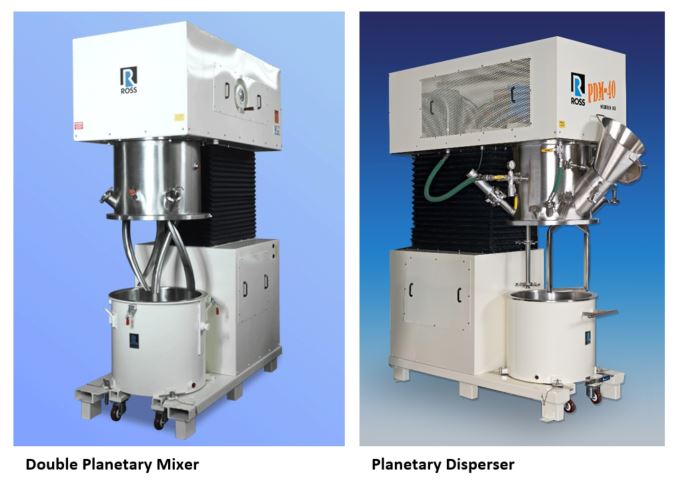
Polymers and additives
Polymer additives such as lubricants, UV and heat stabilizers, colorants, preservatives, flame retardants and impact modifiers are commonly supplied as dry powders or pellets which are blended with virgin plastic feedstock prior to compounding. Thorough and accurate mixing is necessary to achieve a consistent finished product.
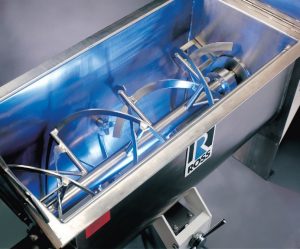
Ribbon Blenders are economical yet highly efficient equipment for dry blending polymer pellets or beads with solid additives. Ingredients are loaded into the U-shaped trough and mixed by a horizontal solid-shaft agitator consisting of inner and outer helical ribbons. A full load corresponds to a product level around the outer ribbon’s tip, allowing enough headroom for the materials to be vigorously agitated.
The position and precise pitch of each ribbon produce a well-balanced axial and radial flow pattern, promoting fast and thorough mixing despite differences in particle shape, size and density. Maximum tip speeds in the neighborhood of 300 ft/min are typical but with variable speed control, the blending action can be fine-tuned and optimized according to the characteristics of a particular recipe.
Gel coats
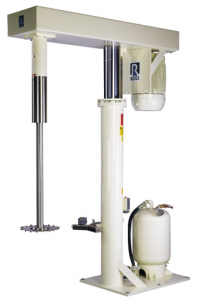
Gel coats (or gelcoats) are modified resins applied to molds in the manufacture of fiber reinforced plastics. They are often used to provide a durable, colored and glossy surface to the finished composite but also serve other functions such as protection against UV damage, water absorption and chemical exposure.
High Speed Dispersers are reliable workhorses used throughout the coatings industry for preparing various formulations including gel coats. Normally supplied with a sawtooth blade, the High Speed Disperser generates a characteristic vortex on the liquid surface into which dry powder ingredients are added. Large, loose agglomerates are rapidly disintegrated, accompanied by an increase in viscosity. As the batch thickens or increases in volume, blade speed is adjusted to maintain the vortex and rate of material turnover.
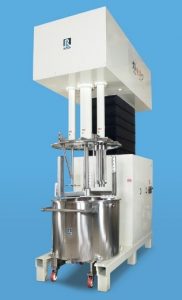 Sample mixing procedure: Thermoplastic modified epoxy
Sample mixing procedure: Thermoplastic modified epoxy
Objective: Dissolve polyethersulfone (PES) into viscous epoxy resin.
Machine: Ross VersaMix Multi-Shaft Mixer
Steps:
- Charge different grades of epoxy resin into the vessel.
- Heat to 200 degrees F.
- Start the agitators and add PES pellets through the sight port.
- Seal the mixer and establish full vacuum, around 29.5”Hg.
- Continue mixing. Shear produced by the disperser blade and rotor/stator mixer breaks down the pellets into smaller pieces and accelerates dissolution. The three-wing anchor agitator scrapes the vessel sidewall and bottom surfaces, ensuring superior heat transfer.
- Stop mixing and relieve vacuum. Final product is a clear amber liquid with no air voids or undissolved PES particulates.
- Open discharge valve. Discharge product into release liners and allow to cool.
Plastic Injection Molding and Extruding
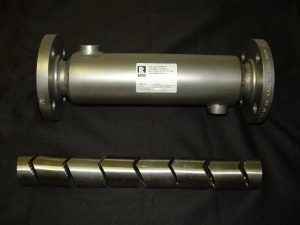
Interfacial Surface Generator (ISG) Static Mixers are particularly ideal for use in injection molding and extrusion applications. Molten material is pumped through a series of static mixer elements installed within the nozzle just before the die assembly. This offers several advantages including:
- thermal homogenization
- uniform viscosity and density
- enhanced mixing of colors and minor additives
- efficient use of all raw materials
- elimination of streaks or clouds in the finished product
- consistent quality and higher yield (less rejects)
Within a very short length of pipe, the static mixer is able to correct various inconsistencies in the extruded stream.
The ISG (US Patent No. US3404869) consists of solid elements bored with four holes which provide the flow paths for the process fluid. The elements are machined to a precise shape such that they can be stacked and form a sealed tetrahedral chamber between adjacent elements. Mixing is obtained via division of the input stream(s) into sub-layers, recombination of the sub-layers into a main stream and subsequent division, repositioning and recombination, so on and so forth. For instance, if two input streams enter the ISG Static Mixer, the number of layers emerging from the first, second and third elements are 8, 32 and 128. This exponential progression generates over two million layers in just 10 elements.
Plastic Resins
Plastic resins attract moisture from ambient air. Water collects on the surface of the resin, and if the plastic is hygroscopic, the polymer retains water within itself. Drying is an important operation in plastics production because excessive moisture in the starting resin material can result in visual defects, lower strength and reduced performance of the finished part.
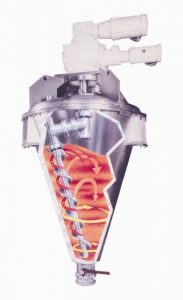 Vacuum-capable Vertical Blender/Dryers are proven equipment for drying plastic resins. These machines feature a slow-turning auger screw orbiting a conical vessel. As it turns, the screw gently lifts material upward and towards the center of the batch. At the same time, product from the top cascades back to the bottom while mixing with materials being moved upward by the orbiting screw.
Vacuum-capable Vertical Blender/Dryers are proven equipment for drying plastic resins. These machines feature a slow-turning auger screw orbiting a conical vessel. As it turns, the screw gently lifts material upward and towards the center of the batch. At the same time, product from the top cascades back to the bottom while mixing with materials being moved upward by the orbiting screw.
During the drying cycle, hot water, oil or steam is recirculated through the vessel jacket. Requiring relatively low temperatures to drive off moisture, vacuum drying is an excellent method for processing heat-sensitive plastics without fear of thermal degradation. The low energy consumption also minimizes operating cost.
Unlike in conventional ovens, tray dryers and hot air dryers where product is stationary, the layer of material contacting the Vertical Blender/Dryer’s heated sidewalls is constantly being renewed. Coupled with vacuum conditions, this continuous turnover of the material leads to significantly shorter drying rates. Moreover, the blending action is gentle enough for even the most delicate of applications in which other agitated dryers (i.e. ribbon or paddle style blenders) may otherwise generate fines.
Paid content provided by Charles Ross & Son Company.
The views, opinions and technical analyses presented here are those of the author or advertiser, and are not necessarily those of ULProspector.com or UL Solutions. The appearance of this content in the UL Prospector Knowledge Center does not constitute an endorsement by UL Solutions or its affiliates.
All content is subject to copyright and may not be reproduced without prior authorization from UL Solutions or the content author.
The content has been made available for informational and educational purposes only. While the editors of this site may verify the accuracy of its content from time to time, we assume no responsibility for errors made by the author, editorial staff or any other contributor.
UL Solutions does not make any representations or warranties with respect to the accuracy, applicability, fitness or completeness of the content. UL Solutions does not warrant the performance, effectiveness or applicability of sites listed or linked to in any content.



Leave a Reply or Comment